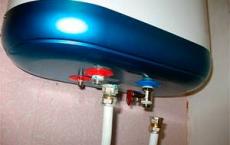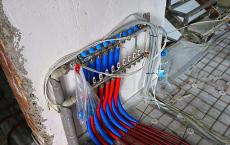Provision of hot and cold water. Radial distribution of water supply pipes: necessity or excess
If you started repairing an apartment, you can hardly limit it to one room. After all, the new interior of the room is not so compatible with the interior of other rooms. In this regard, there is a need to buy new wallpaper, furniture, as well as repair the floor and ceiling in other rooms. And when the overhaul begins, it will affect everything: sound insulation, heating and air conditioning, wiring and even water distribution in the apartment.
Installation of water supply systems
The water supply system is a system of technical devices (fittings, stop valves, filters) and pipes that provide water to the apartment. But the water pipeline only then will perform its functions as efficiently as possible when it is professionally designed and assembled. Otherwise, during its operation, failures can not be avoided.
The specialists of the company "Vodokontrol", having a huge practical experience in creating projects of water supply systems, will design a water pipe of any complexity for residential buildings and for industrial or public buildings, taking into account the wishes and needs of each client.
It should be mentioned here that before the engineers begin to design, they will need some tips from the customer, for example, he must tell what type of wiring he wants to install in this room or building. This issue should not cause difficulties, because the choice should be made of only two options: collector or tee. Despite the fact that the design schemes of water supply systems there is much more - all of them or derivatives of one of the two options, or created as a result of their combination.
Comparison of the tee and collector circuits
Triangular wiring diagram
This scheme of wiring the water supply system in the apartment is a series connection of pipes from the common riser to the places of use of water (shower, taps, toilet, washer). Initially, the main pipes are removed from the cold and hot water, then from them with the help of tees make branches.
The tee scheme is the simplest and inexpensive option. Before designing the wiring, the specialist should provide information on the tee and collector schemes, and also indicate the cost of these options
Advantages of the trigeminal scheme include:
- low cost;
- simplicity of installation;
- compactness.
Disadvantages of the trigeminal scheme:
- with simultaneous inclusion of two points of water consumption, there are pressure differences;
- to cover one point of water consumption will not work, you have to cover the water in the whole apartment;
- it is sometimes difficult to conveniently place tees.
In some cases, it is possible not to shut off the water completely while performing the repair. For this purpose, a faucet is put before the plumber, which, if necessary, can be closed.
The tee scheme is best suited for a small apartment, in which it is easier to match the flow of water at different points. But this layout of the water supply system in a private house can cause a number of inconveniences, especially if it is installed in large cottages. For them, the collector wiring diagram is more convenient.
Collector wiring diagram - the best option for large houses
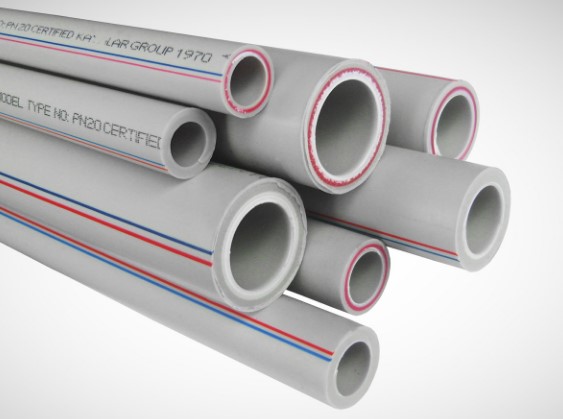
With a collector scheme for wiring the water supply system, separate pipes are supplied to each place of water consumption. At the same time, water is supplied to every point of water consumption (shower, sink in the kitchen, toilet) in the required volume independently of the others. Pipes are fed from the collector, which is installed at the inlet of the water pipe into the building. The collector is a device that has one input and several leads. The number of pins is selected depending on the number of water use points. It is necessary to take into account not only the cranes, but also various household appliances, water on the street and so on.
When studying the collector scheme of the water supply system, it can be clearly seen that all points of water use are independent of each other. This is very convenient both during operation and during repair work. The collector should be installed only after the pressure reducers and filters for water purification have been installed.
Advantages of the collector wiring diagram
The advantages of this scheme are many.
1. Without prejudice to the residents of the house, you can, for example, turn off the water in the shower, while there is an opportunity to use other water consumption points quite calmly.
2. All the control valves of the water supply system are located in one place, they are easily accessed. Usually the collector is located in a plumbing cupboard, or a separate room is allocated for it.
3. The pressure in the system is always stable. Collector wiring protects you from water pressure drops, ensuring that in the shower, for example, you do not get a burn from boiling water, if someone opens the water in the kitchen.
4. The risk of breakdowns is reduced to a minimum and repair is simplified - after all from a crane to a collector there is only one one-piece pipe. In private houses, when installing a collector water pipe, it is possible to hide the pipes even under the screed: whole pipes rarely need to be repaired.
5. The water temperature in all places of its consumption is the same, even when you need to open all the cranes at the same time.
6. Installation of new cranes or household appliances using water is performed quickly. And this will not affect the work of other consumers. To do this, you only need to install a collector that has a supply of several leads.
Disadvantages of the collector wiring diagram
A large number of construction materials will be required to install a collector water pipe. Here two pipes can not do. And this, in turn, will lead to significant material costs. In addition, it takes a long time to complete the installation of a water pipe in this scheme.
In addition, to accommodate the collector and the number of pipes, you need a lot of space. All this behind the locker can not be hidden.
Choice of water pipes depending on the wiring diagram
If the apartment is planned to make the distribution of water pipes according to the tee scheme, it is best to use pipes made of plastic or polypropylene. Connections in progress plastic pipes with the help of special welding. In polypropylene fittings (connection parts) there are threaded metal connections.
To date, polypropylene pipes are the most affordable in the market. They weigh a little and will last about 30 years. As sealing materials, plumbing liners, FUM tape or pastes are used.
For wiring installation collector type use water pipes from metal plastic. They are designed to operate under high pressure, bend well, and cut them with the help of conventional precision scissors. For their installation use collet fittings.
Pipes made of copper are not afraid of corrosion. They are distinguished by their durability, wear resistance and unique bactericidal properties. They serve much longer than any other - from 50 to 100 years. But copper pipes are an elite option - ordinary buyers are repelled by their high cost.
When installing a water supply system, you need not only to select pipes and connections correctly, it is also necessary to protect the pipes from external unfavorable factors. Abrasive friction, wandering currents, condensation, corrosion, mechanical damage and heat loss - due to each of these factors, there may be a need for repair and additional costs.
It is necessary to pay attention to the next moment! Often in multi-storey buildings, mixed water distribution schemes are used: on the floor of the riser, water is supplied through a tee system, and inside the water supply of consumers is carried out by a collector system. It is necessary to take into account the condition of clause 11.5. SNiP 2.04.01-85, which states that hot and cold meters cold water must be installed in a convenient place for maintenance and taking measurements. Indoors it is necessary to provide artificial or natural lighting, and the temperature of the indoor air should not fall below 5 ° C.
In this case, it will not be superfluous to recall that the scheme for laying pipes depends on the way the water pipe is routed. For example, if the main highway is laid through a bathroom, and in the kitchen there is a return, then the best option will connect the sink and dishwasher in a serial connection, and the wiring in the bathroom will be designed depending on the number of consumers.
What method of wiring will be most effective in this or that case, as if only experienced specialists can know.
The company "Vodokontrol" - quality, time-tested
Specialists of the company "Vodokontrol" will perform the pipe routing in the shortest possible time, while trying not to disturb your comfort. During the work our masters use only modern high-quality equipment. This guarantees a high quality of installation. The employees of our company are real professionals and craftsmen.
The company "Vodokontrol" is known in the market of plumbing services for almost ten years. In the staff of our employees there are specialists - plumbers, who have 30 years of experience in this profession.
Plumbing works are a very responsible activity that does not forgive negligence and negligence in the work. In this regard, we pay special attention to the personnel issue. All masters of the company "Vodokontrol" have experience in plumbing works for at least 5 years.
The distribution of water supply pipes in the apartment is a problem that has to be solved during the overhaul. Sooner or later there comes a time when the water supply system becomes unusable. The reasons for repair and replacement of the water pipe can be many, we list the main ones - the formation of fistulas, condensate on the pipes, the appearance of rusty water from the tap,
Is it possible to replace the water supply system in an apartment or a private house on its own? After all, the work of plumbers will not be expensive. And in this question the answer is yes, it is possible. At the same time, you do not need special permissions and design for the work. All that is necessary is to cut off the supply of water to the riser for an hour.
All work on the installation of water supply systems will have to be carried out in strict sequence, otherwise the constructed structure will not work accident-free.
The construction of the water supply network begins with the selection of the pipe materials. Recently, household steel mains are not installed often. This material has already lost its popularity.
His place was taken cheaper and more practical constructions from plastic and metal-plastic. You can also use copper water supply systems, but their too high cost in this variant causes the rejection of this material.
- Copper. Despite the numerous positive features, this highway is not without some disadvantages. The first one is harmful copper oxide, which is formed by contact with an aqueous medium. Second, solder is used for tin soldering. This material eventually turns into a powder, which leads to the leakage of the joint.
- Metal-plastic. This material does not belong to the line of cheap materials, but it can be combined without using special tools. The laying of such a pipeline is allowed in an open area, where at any time it is possible to quickly cross the joint.
- Plastic. These systems are called the standard of water supply systems. But the plastic is different. And to make the right choice, you need to know the properties and features of these materials. For example, a material such as polybutylene (PB) is distinguished by optimal thermal conductivity. Joints of this type of plastic differ absolute reliability.
 Polyethylene (PE) not expensive material, but for hot water supply (GVS) will have to put reinforced products. With significant drawbacks, this material has a very significant advantage not to burst after freezing. Therefore, such a trunk works successfully in a room without heating or on the street. Polyvinyl chloride (PVC) is chemically stable, but unstable and collapses when exposed to ultraviolet light.
Polyethylene (PE) not expensive material, but for hot water supply (GVS) will have to put reinforced products. With significant drawbacks, this material has a very significant advantage not to burst after freezing. Therefore, such a trunk works successfully in a room without heating or on the street. Polyvinyl chloride (PVC) is chemically stable, but unstable and collapses when exposed to ultraviolet light.
Polypropylene piping for water supply in an apartment will not be very expensive. Such a water main is currently used more often than others. This material is distinguished by its strength and durability.
The soldered polypropylene junction on the wiring reliably withstands the pressure load up to 12 atmospheres, and differs little from the main material. In the city pipeline can be up to 6 atm, so this range for polypropylene wiring in the apartment is ideal. The piping for water supply in an apartment using polypropylene has a higher hydraulic resistance than previous analogues and increased thermal stability.
Describing the characteristics of polypropylene wiring, you need to remember about their shortcomings. They have only two polypropylene. The first - polypropylene can not be glued, and when welding you need to use special equipment, and accurately follow the entire technology of plumbing work. Secondly, polypropylene has a significant coefficient of thermal expansion, which must be taken into account when performing the installation.
Watch the video
The piping of water supply pipes in the apartment where polypropylene is used is recommended by the masters as the only system at the moment, which after proper installation does not require permanent maintenance. It also needs to be added that polypropylene is soldered at a lower temperature than other types of plastic.
Choosing a way to distribute water in the apartment
The plumbing of the water main can be carried out by the tee-off method (it is classed as classical variants). And can be produced by a modern collector method.
The first method is the sequential carrying out of the main line from the common riser to the places of analysis. Initially, the main branches are diverted with various water, and then by means of a tee, the water moves along the branches.

The classical scheme has the following advantages.
- A small price.
- Compact dimensions.
- Simple gasket.
She has the following disadvantages.
- Constant pressure drops.
- The impossibility of overlapping a single point of consumption.
- Tees are not always convenient to place in the bathroom or toilet.
- For a small apartment such wiring is acceptable, but in a large a country house this will cause a lot of inconvenience.
Collector wiring conducted for water supply in an apartment or a private house is the way in which an individual pipe is drawn to each point of the fence. With a collector structure in the apartment, a sink, toilet, shower cubicle and all other plumbing fixtures deliver water to the necessary quantity independently of each other.
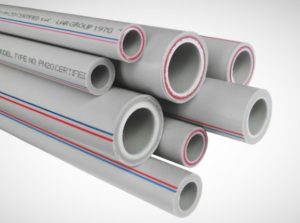
All pipes lead to the collector, which stands at the entrance of the main line to the housing. Collector construction is a system equipped with one input and several outputs. When connected to it, not only the number of valves is taken into account, but also the number of all plumbing fixtures.
TIP. Connection of the collector structure to the housing can be made after the connection of filtering mechanisms for water purification and pressure reducers.
The manifold distribution of water supply pipes in the apartment has numerous advantages:
- The first is the possibility of turning off the water at one of the points, without affecting other water intake sites.
- The control cranes of this system are located in one zone, and there is always free access to them.
- Constant stability.
- The risks of breakdowns are minimized. And if you need to make repairs, then it can be done easily and quickly.
- All points of water intake have the same level of water temperature.
- If necessary, you can quickly connect a new valve or plumbing. For this purpose, it is first necessary to install a collector structure with several spare outputs.
Watch the video
Perhaps the only drawback in this case is the need for a large number of building materials. After all, "a couple" of pipes in this situation can not do. Accordingly, such a scheme will require tangible financial costs. In addition, this design will require a lot of space.
Water Distribution Circuit
The layout of the water supply pipes, most of all, is necessary for the owner of the apartment. A detailed plan helps you to accurately navigate the location of the various elements of the highway. There will not be a special permit for a detailed plan. Only when the meter is taken into account, the workers of the municipal water utility can ask for this scheme.

To create a complete scheme for all norms even for a professional master is a serious work. Because such a scheme for a country house with summer kitchen is needed for project approval. For an apartment it is enough to draw a diagram where everything will be simple and understandable. Such a plan should include:
- Pipes of water supply.
- Accounting mechanisms.
- Plums and valves for an emergency situation.
- Stop valves.
- Places of water extraction.
- Branches for rezovnogo use.
- Direction of water movement.
Collector and any other distribution of water supply pipes should be carried out according to a scheme that will be clear not only to the owner of the apartment. Therefore, for the drawing of a collector and another scheme, there are certain norms and rules. It is recommended that:
- do not use isometrics, otherwise the intersections of the pipes will confuse the entire collector or T-piece.
- Do not use overly arrows - pointers to avoid confusing the plan.
- The shut-off valves and meters must be specified in accordance with the rules and clearly.
- Diameter and type of pipes must be specified.
As a result, it turns out that the collector or tee scheme should be compiled according to strictly defined norms and should be without excesses.
How to calculate pipe diameter
The diameter of the distribution of water supply pipes should be calculated correctly. And such a calculation is needed for a reason. The smaller the diameter of a pipe, the less it costs. And with reverse side The excessively small diameter of the pipeline causes fluid turbulence. At the same time, the throughput function of the highway falls, and at a normal level of pressure from the tap, water will flow very poorly.
For a pipeline in an apartment, you can calculate the diameter yourself. The initial parameters are as follows:
- The smallest pressure is 0.3 atm.
- For 1 meter of pipe product at 16 mm, the pressure loss can be 0.05 atm.
- For one fitting connection, the pressure loss is possible by 0.15 atm.
- At the point of water intake, the loss is 0.25 atm.
- The headroom for the outermost point can be no less than twofold.
Now, it is necessary to find out whether the serial distribution of water pipes in the apartment will have the necessary pressure at the furthest point. Will there be enough for a consistent design of the running range, or you will have to purchase larger pipes.
The pressure level at the bottom of the risers is determined by means of a pressure gauge, then taken away at 0, 6 atm per floor. But in multi-storey buildings such a calculation is not acceptable. In order not to increase the cost of construction in housing, the risers are taken separately from the structure. First it is done on the lower, and then on the upper and middle floors.
Horizontal distribution of water supply pipes is characterized by non-linear dependence of heat loss in the pipeline. Such losses are dependent on the velocity of the flow, which in turn depends on the cross-section of the pipe structure.
The slightly increased diameter of the assortment significantly reduces heat loss. For these reasons, a simple design in an apartment of 20 mm, having bends of 16 mm functions properly.
What tools and materials will be needed when working?
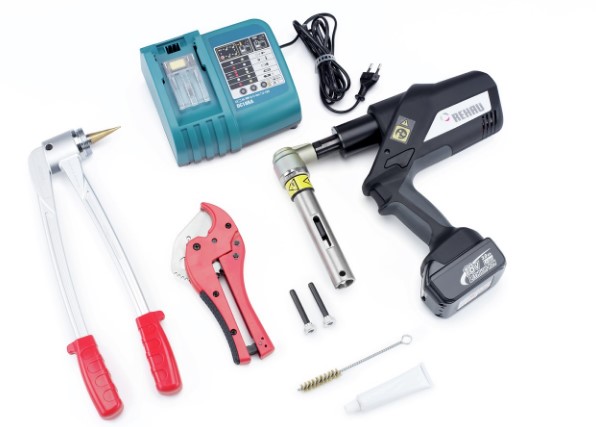 To work on building a trunk, you need a standard set of tools. These are: a welding machine, a tape measure, devices for cutting and bending pipes. Before purchasing materials you need to carefully approach the calculation of the footage.
To work on building a trunk, you need a standard set of tools. These are: a welding machine, a tape measure, devices for cutting and bending pipes. Before purchasing materials you need to carefully approach the calculation of the footage.
Also, before the installation, produced by hand, will have to dismantle the old pipeline. This replacement is performed by traditional methods. In the apartment, it is better to do this after turning off the water meter, so as not to disconnect the water supply to other floors for a long time.
Another tip that is useful in this situation, you should not take a valve with a lever. It is made of plastic, which has the property of breaking at the most inopportune moment. It is better to use a ball device with a butterfly shaped handle to shut off the water supply.
Mounting the wiring by yourself
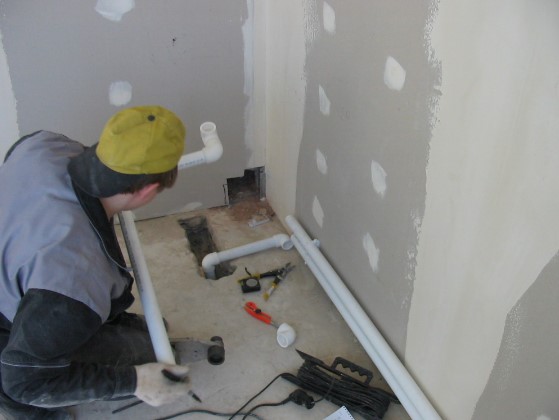 So, the system build has come. Directly. This is absolutely not a complicated process, which even the beginning master can shoulder. If you stick to the technology of this work, you can eventually get a design that will function reliably and for a long time.
So, the system build has come. Directly. This is absolutely not a complicated process, which even the beginning master can shoulder. If you stick to the technology of this work, you can eventually get a design that will function reliably and for a long time.
Just consider carefully the strobleniu and the arrangement of canals in the screed. They should not pass no more than 150 mm from the wall and not less than 20 cm to the furniture. All plumbing must be removed and removed from the premises before starting work.
At the initial stage of the action, arcs are established. These are plastic slats with corners for mixers. They are fixed to the main wall by screws. Carrying out this fastening, it is necessary to take into account the dimensions of the finish. It can be plaster, tile or any other decoration.
If home master has no significant skills, then it is difficult to accurately position the output blanks. It is recommended to pre-perform them with a protrusion for a distance equal to half the width of the bead of the caps on the mixer. If these caps are not regulated, then they are not recommended to "fit" through an emery circle.
Watch the video
The next step is to connect the sections of the main line. It is more convenient to collect water supply on the table, and broach in the grooves in a unified form. But, now the question naturally arises, how to stretch the structure through the walls?
In the case of metal-plastic, this is not a problem, such a line is made on split fitting parts. A soldered pipe products are made using adapters and metal-plastic inserts. The second more reliable way is to install the network on site. Only for such actions it is necessary to get a compact welding machine.
Just need remember that cold and hot water will need individual units for accounting devices. In this case, it is recommended that the counters and the valve handles stand out in color.
The readings on the meters must be viewed conveniently. For this reason, this zone of the highway is often performed in a very bizarre form. . This seal should be preserved, without it the device is considered unfit.
After installing the meter, call the inspector from the water canal. It records the data on the device, and seals the counter and drains the filter with its seal.
Watch the video
For cutting pipes it is better to use a pipe cutter. By working on this tool, you can not only save time, but also more qualitatively prepare the tube materials for soldering.
Also, special attention should be paid to the bending of the tubular assortment. When working with metal plastic products, it must be remembered that the minimum allowable level of bending is equal to five external volumes of the tubular product.
And at the final stage, the boiler is mounted. These actions were included in a separate cycle of installation works. Such work is done after putting the pipeline into operation. Pipes for the boiler are prepared in advance. Near both nozzles, valves are placed, and at this stage they are immediately shut off and additionally drowned.
In the issue of home repair, you can not ignore the installation of pipes in the bathroom and toilet. The wiring diagram should simultaneously provide a convenient location of plumbing fixtures, access to key components for repair and fit well into the current or future interior.
Often, when repairing in old premises, it is necessary to replace worn out water risers and supply pipes. In this case, you can face certain difficulties, because not all obsolete and faulty elements can be replaced with modern ones. Very often the new plumbing is different in installation dimensions, the diameter of the connecting thread and the method of attachment. In such cases it is necessary to provide a new scheme for supplying and connecting plumbing fixtures.
Works on pipe routing are mandatory if the bathroom is equipped from the ground up.
We will discuss in more detail the methods and rules of water distribution.
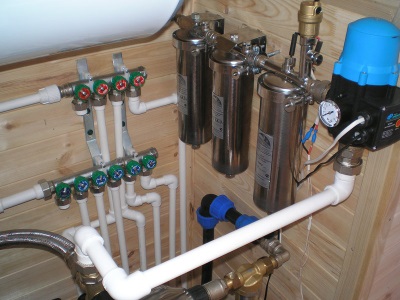
Development of the layout of facilities and pipeline
The layout of the connecting elements, cranes, water meters and pipe elements will be absolutely necessary for a qualitative result. It will help to calculate the number of connections and taps, to determine the location of the plumbing and to save time and materials.
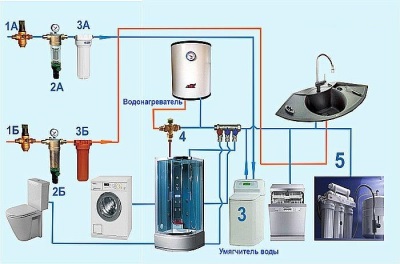
Standard wiring diagrams include the following mandatory elements:
- Water meters;
- Shutoff and control valves;
- Filtering elements;
- Fittings (couplings, corners, seaweeds, adapters);
- Reducing valves;
- Check valves;
- Approach from the riser to the heated towel rail;
- Sewer collector.
Deciding for yourself where the plumbing devices will be located, you, based on their dimensions, calculate the length and diameter of the feeding areas. After calculating the length of the sections and the number of additional parts, it remains to choose the appropriate kind of wiring.
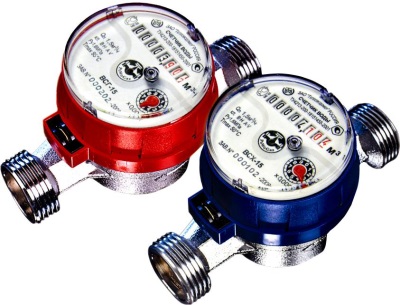
Types of pipe routing
At the moment, in plumbing works the following 3 types are recommended:
- Collector (from parallel connection each object to the main pipes);
- Sequential (connection of each object to the main pipe through a separate tee);
- With plug-in sockets (similar to the serial, but instead of tees install sockets).
The last scheme of laying is used only in private houses. It will require the installation of an additional pump for supporting water and laying pipes of considerable length.
In the apartments, the first two schemes are used, they will be described in more detail.

Collector wiring
Among the existing proposals for the organization of water supply is the most reliable and practical. Each consumer is connected through its supply steam, with the help of cranes, the water supply to it can be adjusted at any time or completely cut off. Cranes are located on one small collector, which is hidden in a special cabinet. The supply pipes have a minimum of connections, and their laying can be carried out concealed.
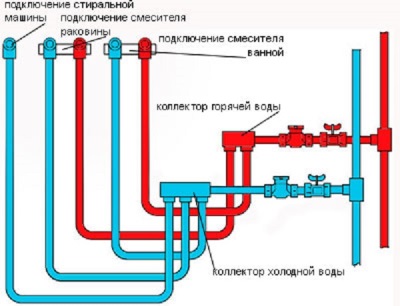
Of course, this option is quite expensive, because need stopcocks for each connection to the manifold. The work itself is laborious and will require accuracy of calculation and execution, so it will be more reasonable to entrust it to an experienced master. But the advantages are obvious: for maintenance and repair of washing machines, mixers and other devices do not have to disconnect from the water supply all the bathroom at once.

Sequential wiring
This type of pipe laying is applicable for rooms with a small number of consumers (a common mixer for a washbasin and a bathtub and access to a washing machine). A sequential scheme is convenient to implement if the bathroom is finished finishing work. Pipe laying using this scheme, as a rule, is open. In the tee scheme, the pipes have a small number of connections and are compact. The process of assembling itself is straightforward - you simply lay the main line from one consumer to another along the way bringing out the supply tubes from the tees. Such a procedure does not require the expenditure of a large amount of materials and additional expenditure.
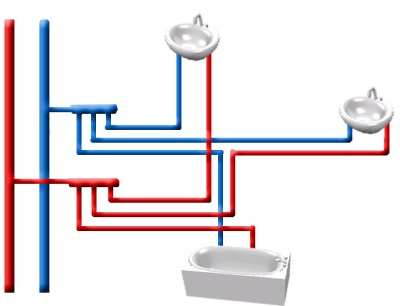
But when your bathroom has a lot of water intake points (separate faucets for a washbasin and a bath, a boiler, a washing machine, a bathroom, a dishwasher), the work of this scheme becomes unsatisfactory. There may be a lack of water pressure for the simultaneous operation of all consumers.
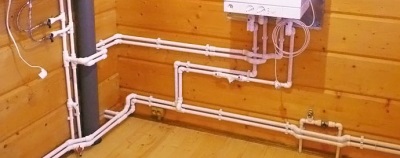
In both cases considered there are a number of nuances that are always taken into account when assembling the water supply scheme:
- The number of connections must be minimal;
- The pipe and couplings must be made of homogeneous materials;
- Pipes should be heat-insulated so that condensation does not settle on them;
- You need free access to plug-in connections, filters and meters.
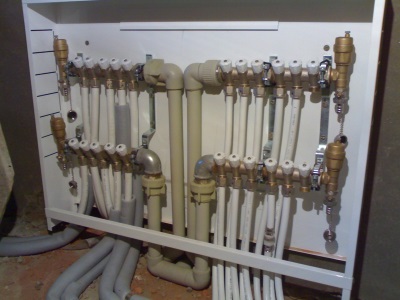
The right choice of pipes and their varieties
When considering piping for communications, note that the various materials are adapted for certain operating conditions and are seriously price different.
Thus, metal pipes are made of galvanized steel or copper. The former are characterized by good heat transfer and strength. The latter are more durable and easily accept the given shapes, but at the same time are the most expensive.
A cheaper alternative to steel and copper is plastic products. Plastic and metal-plastic pipes almost completely replaced the stainless steel pipes in the plumbing sector. Easy to handle and durable, they have made progress in quality and speed of installation.
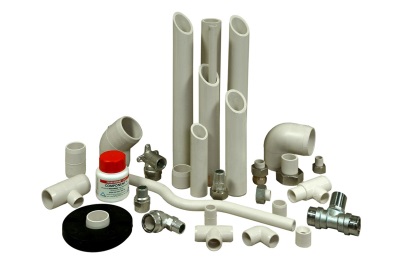
Among their advantages, we note the following:
- pipes are easily connected by soldering, the joints themselves are resistant to pressure drops;
- plastic is not susceptible to corrosion, the internal surface is not silted and does not become lime;
- products from polypropylene are cheaper than metal.
It is worth noting that pipes made of metal-plastic are less plastic, brittle and do not tolerate water hammers. Metal-plastic products are usually used for sewage collection.
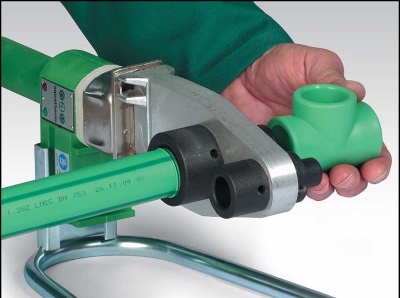
Hidden, open and combined method of laying pipes
The layout of communications in the bathroom can be arranged in 3 ways.
External wiring. Occurs when it is impossible to hide the pipes in the walls. This type of wiring allows you to constantly monitor the appearance of the connections and easily disassemble them in the event of clogging or replacement parts. Also, it is cheaper at attracting installers to the installation - from 7,000 rubles together with materials.
Concealed wiring. Due to the fact that all connections and areas are hidden under the lining, and only fittings for connections are outwards, this type of liner does not violate the interior design. Pipes are securely hidden in the walls can not be damaged by carelessness. But the process of doing laying works takes more time and effort. Before laying the walls, shtrobyat - cut channels for the placement of pipes. After laying the walls are closed, while maintaining the plane. Pipeline before installation should be clad in a casing according to construction norms.
As a result, the hidden method of laying is much more expensive than the distribution of pipes outside (from 12,000 rubles). Well, if we talk about bearing walls, then slugging them is prohibited in principle.
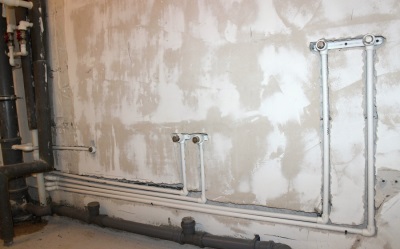
Hidden laying is possible only with unfinished finishing works. With the finished cladding, only an open and combined pipe assembly is possible.
Combined gasket is to lay pipes on the surface of unlined walls with subsequent installation of decorative false panels or boxes that hid the pipeline. This is a rather difficult method, since it will be necessary to harmoniously enter the projecting parts of the box into the interior and keep the cozy atmosphere in the room. Here, the profiling of the shape of the box by means of plasterboard and the external finishing with tiles and decorative elements come to the rescue.
Piping to the heated towel rail
The supply pipes can be stretched to the towel heater from the heating stand or from the hot water supply main. It should be noted that when operating from the CO, the radiator will function only in the heating season. Also tapping of bends into the heating system will require for a while to shut off the flow on the riser, that representatives of housing and communal services do for a fee. In winter, such work is not carried out at all because of the risk of freezing the pipe.
Therefore, it will be more efficient to connect from a hot pipeline. At the same time, for convenience and saving of hot water between the main and the heated towel we recommend to put a bypass jumper. It connects the straight line and reverse pipe, a ball Valves Before the coil and after it, it is possible to cut off the towel raiser in case it is replaced or for keeping heat.
When laying the supply pipes, you need to accurately withstand two dimensions: the interaxial distance of the nozzles for connecting the radiator and the minimum distance from the wall of the bathroom. For radiators with pipe diameters up to 23 mm, it is equal to 35 mm, for pipes with a diameter exceeding 25 mm - 50 mm. In general, 2-3 cranes for a bypass jumper, 2 tees for the main pipe and its terminals, 2 tees for the bypass and 2 couplings for connecting the coil are needed for connecting the heated towel rail.
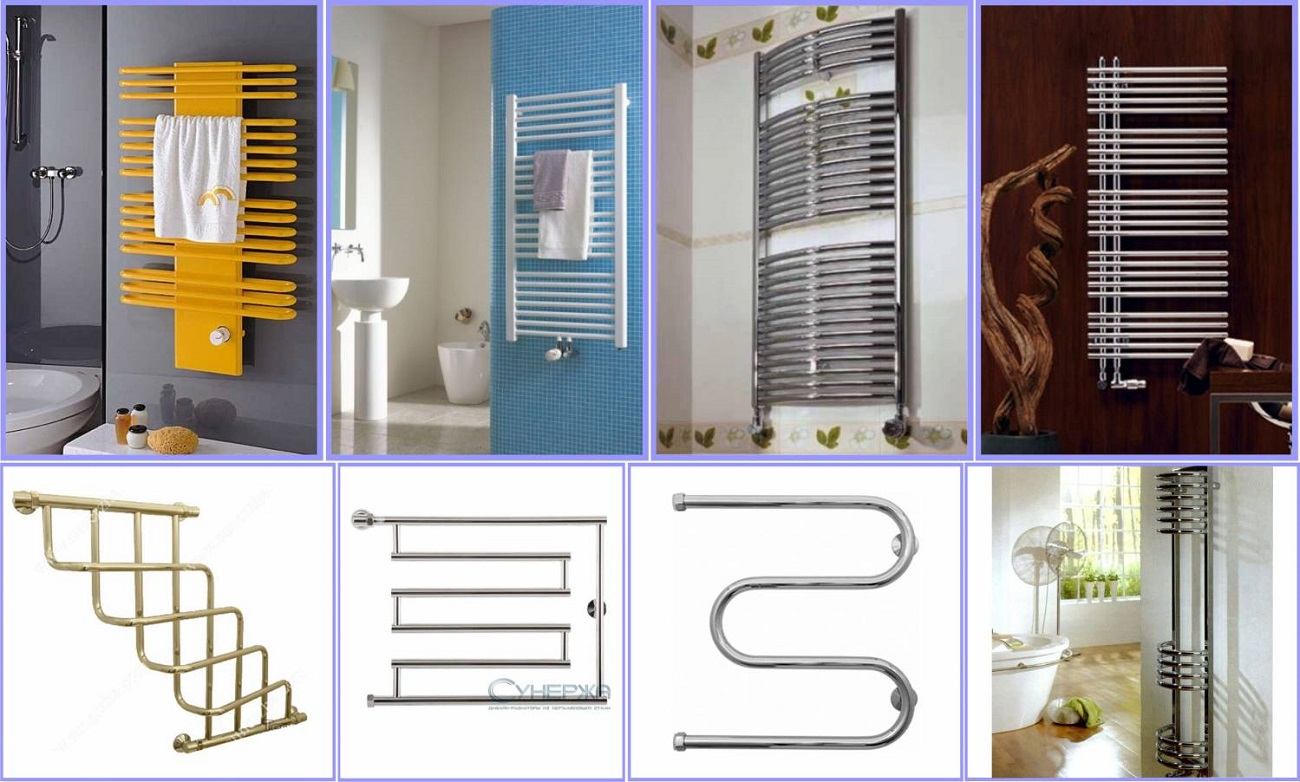
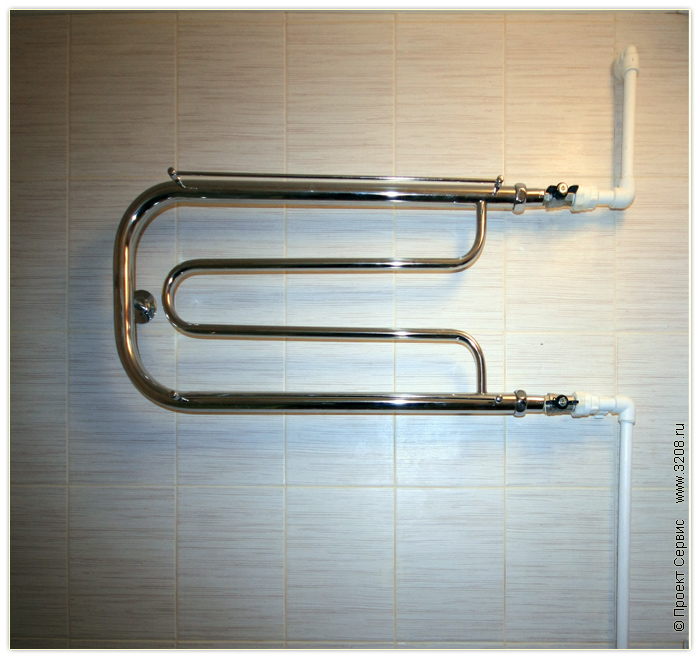
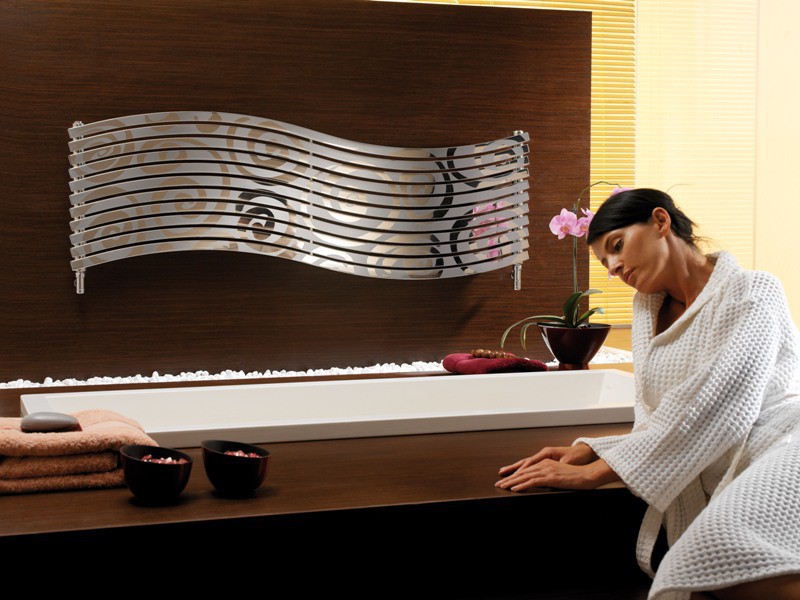
Piping of sewage pipes
Create wiring sewer pipes is carried out taking into account a number of requirements for normal drainage and prevention of water stagnation. These requirements are as follows:
- The slope towards the drain collector is maintained. Its value is from 0.02 to 0.03 of the total length of the gasket.
- When assembling, it is not allowed to place the bends at right angles.
- In the areas before the turns, where possible blockages should be placed revision - tees with a removable cover. When the gasket is hidden, it is necessary to leave a viewing window opposite the revision.
- The diameter of the pipes should ensure a good cross-over for drains. The toilet bowls are connected to the collector pipes by not less than 100 mm in diameter, and the sinks and baths - by pipes with dimensions of 50-75 mm;
- When assembling, leave a margin for thermal expansion: the end of the pipe should not rest on the joint and not reach the bottom by 10 mm.
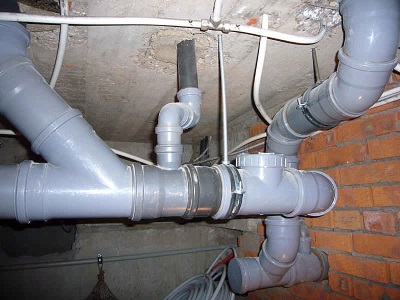
To obtain the required slope value, use the building level when marking the clamp mountings
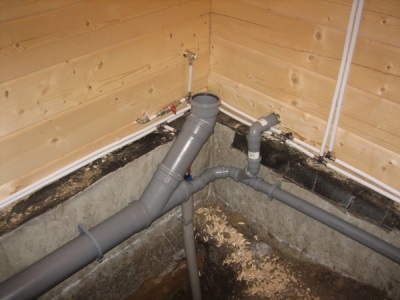
Laying and installation of pipes with own hands
With the finished pipe laying scheme and the selected laying method, you can start assembling the system. It should be noted that it will not be possible to independently assemble the steel and copper pipes. Working with them requires skills in handling the welding machine and the accuracy of processing. Such a force is only an experienced professional. Therefore, in this section we describe the installation technique of polypropylene pipes. It is easy to learn and will require strict adherence to instructions.
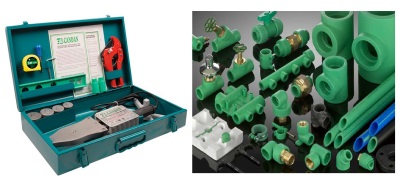
Prepare for work all the necessary materials and tools:
- Soldering iron for plastic pipes with nozzles of the desired diameter;
- Turbinka (Bulgarian);
- Pipe cutter or hacksaw for metal;
- Perforator;
- Sealing winding made of flax or pakli;
- Dowels with self-tapping screws;
- Polypropylene pipes;
- Adjustable wrenches;
- Ball Valves;
- Transitional couplings, bends, tees.
- Filters mechanical cleaning;
- Pressure reducer.
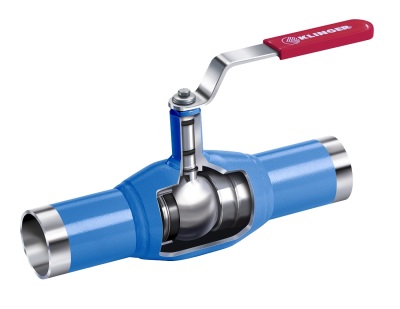
Dismantling of old pipes
You should start by dismantling previously installed communications. To do this, we shut off the water supply and distribute the detachable joints to drain the water. We unscrew all threaded joints and remove old cranes, couplings and tees. Elements, which are still in good condition and do not have any contamination inside, are completely fit for spare parts. Welded joints are cut by the Bulgarian. To get to the sites hidden in the walls use a puncher with a chisel.
If the fitting on the riser is threaded, a new control valve is attached to it, followed by a filter and a water meter. If the old pipe was fixed to welding, then we retreat from the seam of 10-15 centimeters, cut the pipe and cut the thread with a lance.
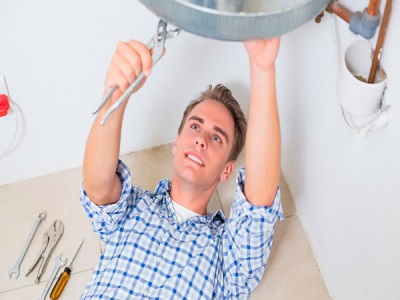
Pipes will be attached to connecting elements by soldering. For soldering, first install the cartridges and kegs of the correct size and turn on the palm. The optimum temperature for soldering 260 degrees, the corresponding mark is on the device's toggle switch.
We advise not to cut all sections of pipes in advance. It will be more correct to connect them consistently, so as not to miscalculate with the size. Cut pieces of pipes with a pipe cutter or a hacksaw. We clean the cut with a clerical knife from chips and burrs.
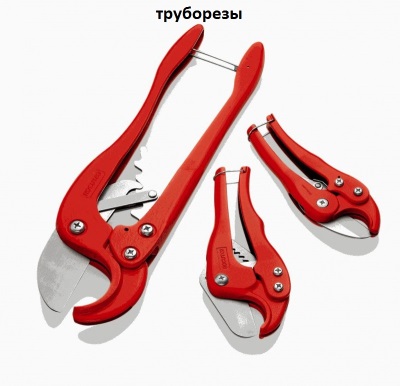
The time for the heating of the parts depends on the diameter and thickness of the pipe walls. You can independently find tables where it is normalized. In normal seconds, 5-7 is enough. The molten pipe or coupling without effort is rotated on the sleeve or pin and can be easily removed. After removing from the soldering iron two parts must be connected instantly. Press it all the way in, but without strong pressure. Within 3-5 seconds, you can rotate the parts, if suddenly set them crookedly. After the connected areas will finally grab and can not be separated any more. For practice, it does not hurt to practice on unnecessary trimming.
Pipes will be fastened along the walls due to plastic clamps. Those in turn are pressed against the walls with screws. Their design makes it easy to fix the pipe by snapping the lock and releasing it as easily.
After completing the installation, we will check the build quality. For a quarter of an hour, open the cold water supply. Then pass the hot water through it at the same time. Carefully check the condition of the threaded and soldered joints. In case of leaks, replace the unreliable connection immediately. In this case, it will be superfluous to stock up a couple more fittings.

Some tweaks to simplify the work:
- In advance, mark and drill the holes for the dowels and secure the clamps. You do not need to tighten the yokes tightly until you try the pipe on them.
- To expose the tees and corners exactly, try them on the pipe before soldering and mark with a marker.
- Pipes can be brazed by weight and the harnesses already assembled must be fastened to the clamps. To collect everything, the previous prompt will help you.

Safety during the laying of pipes
In order to protect yourself at work, prepare yourself a workplace - remove everything that prevents you from approaching the pipe installation sites. Before working in the bathroom, make sure that there are no open electrical outlets and bare wires nearby. After covering the water on the riser, open the duct to all valves to ensure that there are no gaps through the shut-off valve.
Working with the soldering iron will require caution to avoid burns and a fire. Do not leave the soldering iron unattended, always install it on a special stand when not in use. Choose for him a place on a fireproof surface away from flammable materials and liquids.
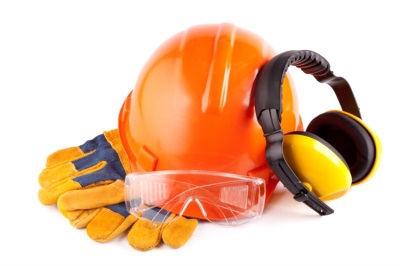
Take care of your own health and safety. Go to work in overalls from thick jeans with long sleeves and pants. Skirt on the feet of good work shoes. Cover your hands with gloves made of durable fabric. To protect the eyes before working with a puncher, wear protective goggles or a mask
People often wonder what the input node is (in the apartment), what it should be and what it should include.
Having received the keys to your new apartment (in a new building), you may notice that the input node will most likely be not qualitatively made - the input unit is made of non-quality material and equipment. The developer does not intend to make an ideal input node, but is limited to a minimum for the delivery of the object.
The composition of the water supply unit in the apartment
The normal input node includes:
- Stop valves;
- System of protection from leaks;
- Filter coarse cleaning;
- The device of the account of water;
- Check valve;
- Fine filter;
- Pressure reducer;
- In exceptional cases (with poor water quality), you can put a main water filter;
- Distribution manifold;
- Water Hammer Compensator
Stop valves in the apartment
Leakage protection system
Even the most reliable and modern system Water supply includes connections with gaskets and flexible piping. According to the statistics of insurance companies, these elements are the main causes of leaks in the apartment.
In order to protect yourself you need to install a system of protection from leaks. The system consists of a ball valve with a servo drive, a control module and sensors. When water enters the sensor, the system gives the command to close the valve.
It is important to take into account that the leakage protection system should be installed immediately after the shut-off valve - this will help to minimize the number of unprotected connections.
There are a lot of security systems on the market, but our company recommends installing the AquaSpare system. It has proved itself well, and the manufacturer provides a good, timely service.
Coarse filter
Often, the quality of water may not be better - in the water can come across large particles of dirt that can disable other appliances in the water supply system. For example, some water meter manufacturers cancel their warranty obligations, if this filter is not installed in front of the meter. Depending on the manufacturer, the coarse filters are available with a grid cell of 600, 500, 300 μm.
Devices for the calculation of water
An integral part of the input unit in the apartment is the water meter. Types of water metering devices and methods of their operation are detailed in our other articles, so we will not consider this point in depth.
It should be noted that in Moscow only water meters with a pulse output and an installation length of 80 mm are allowed to be installed. We recommend using ITELMA water meters.
Check Valve
The necessary element of the accounting node is check valve, which serves to protect against the backflow of water in the water supply system. This makes it possible to prevent mixing of hot and cold riser water (often they have different pressures). It also prevents the water meter from "twisting" when draining water from the riser, so many management companies may not accept the accounting water node without a check valve.
Fine filter

If you want your plumbing equipment to last a long time, you should take care of protection against small particles - it uses a fine filter. These types of filters purify water from particles up to 100 microns.
Pressure reducer
To protect the system from pressure surges, a pressure reducer is used. It allows not only to "equalize" the pressure in the riser, but also to prevent the pressure in the apartment above the selected one. A sharp pressure jump in the system can be attached to the breakage of flexible piping and the flooding of neighbors.
Trunk Water Filters
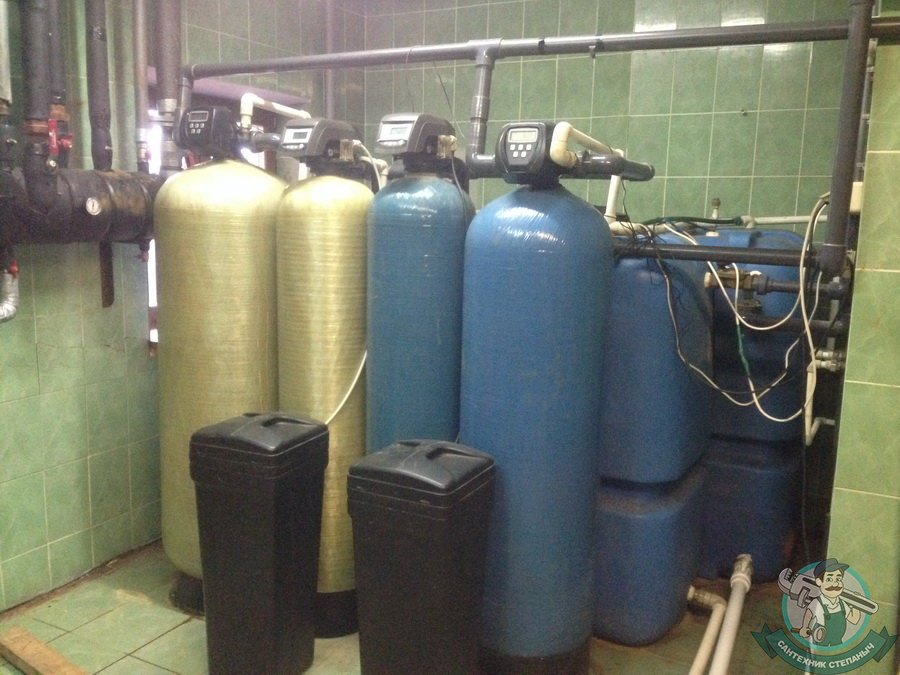
There are situations that the quality of water is very bad - it has odors and all kinds of admixtures of chemical elements that are harmful to human health. In these situations, the main water filters are used. Filter elements are selected according to the results of laboratory studies of water. When installing the main filter, it is desirable to provide a bypass (jumper) - this will allow using water when replacing the filter.
Distribution manifold
Collector wiring is the most functional and modern type of water distribution. Using collector system contributes to reducing the pressure drop while using several points of draw-off at the same time. If necessary, allows you to locally disable the desired consumer. Another advantage of this type of wiring is the minimization of the number of pipe connections inside the walls and screed.
Water Hammer Compensator
The hydraulic hammer compensator makes it possible to "extinguish" sudden pressure surges with rapid opening and closing of the mixer, switching off / on the washing machines and dishwashers, and the toilet valves.
According to statistics of insurance companies, most of the flooding of apartments occurs at night. This is due to the fact that with a small water intake from the riser, the water in the pipes heats up to room temperature, its expansion occurs and the pressure in the water supply system rises. To prevent this, the hydraulic surge compensator allows.
The hydraulic hammer compensator, as a rule, is installed in the end of the collector. They are of membrane type and spring type.
Proper installation of the input node will save you from unnecessary costs and problems. Installing an input node is not an easy task and it is better to entrust this work to qualified specialists. Our company "Plumber Stepanich" employs experienced and qualified specialists.
In this article, I want to find out once and for all whether the collector distribution of water supply pipes in the apartment justifies itself. The reader will not find here any highly specialized computations and complex formulas-only a little common sense and a simple calculation of economic efficiency. So, let's go.
Definitions
First, it is necessary to clarify what and with what I want to compare:
- The triple or sequential wiring is known to the respected reader for Soviet-built apartments. Plumbing fixtures (washbasin faucets, bathtubs, sinks and toilet bowls) are combined by common piping with forks. Its diameter is unchanged from the valves to the outermost instrument and is, as a rule, 1/2 inch (DN 15);
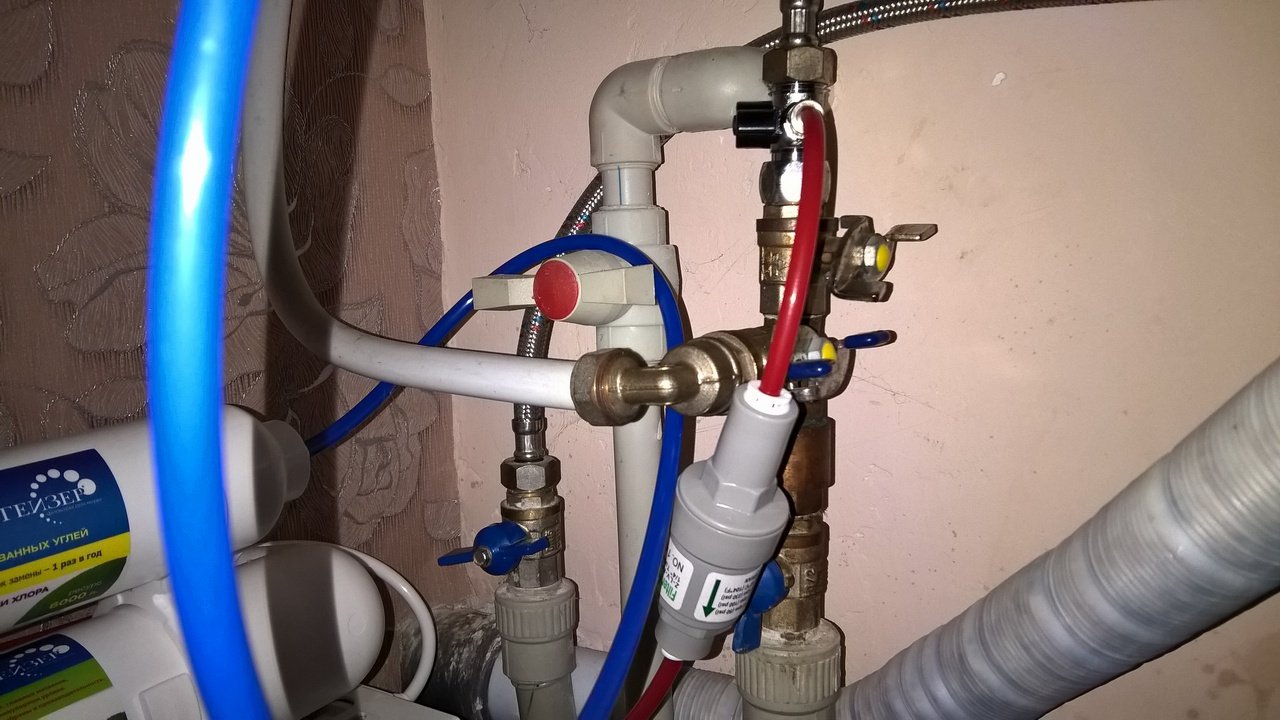
- Collector is called a wiring, in which a pair of pipes is laid from the collector (comb) installed at the entrance to the apartment or to each sanitary appliance.
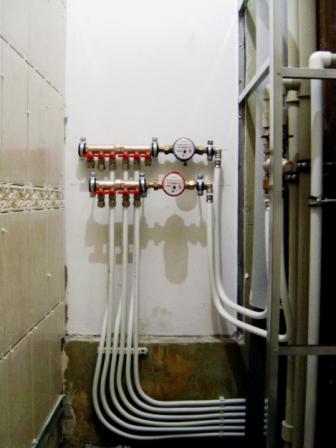
Advantages of the collector wiring
Supporters of this decision give two main arguments:
- No drop in pressure on plumbing fixtures with water flowing through one of them;
If the wife turns on the cold water in the kitchen, the scream of her scalded husband will not be heard from the shower.
- Possibility of independent switching-off of each mixer. If, say, in the kitchen crankbox has turned, you can cut off the corresponding ball valve on a collector and before repair of the mixer to use a washbasin and.
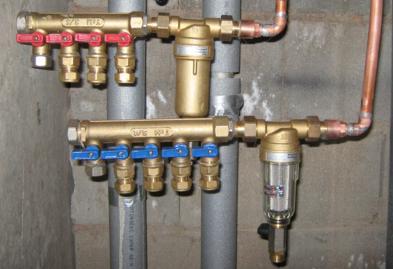
Skeptical remarks
The plumbing of sewage pipes and water pipes in new and old apartments and houses has been carried out by me repeatedly, and i never stopped at the collector wiring of water supply. Heating - as many as you want. Hot and cold water - no.
Here are the main arguments.
Strebs
Sequential water distribution can be performed openly. Gently clamped clips or clips made of modern materials do not need painting and do not spoil the design of the room. Do not spoil until there are only two.
And now imagine four, six or eight parallel water pipes. Of course, they will have to be stacked in Stroblas. And this means:
- Increased workload. To bar a brick wall, or, even more, a panel wall-the work itself is rather tedious; and after all the stitneys need to be also carefully closed, after which the wall will need a thoughtful alignment with putty;
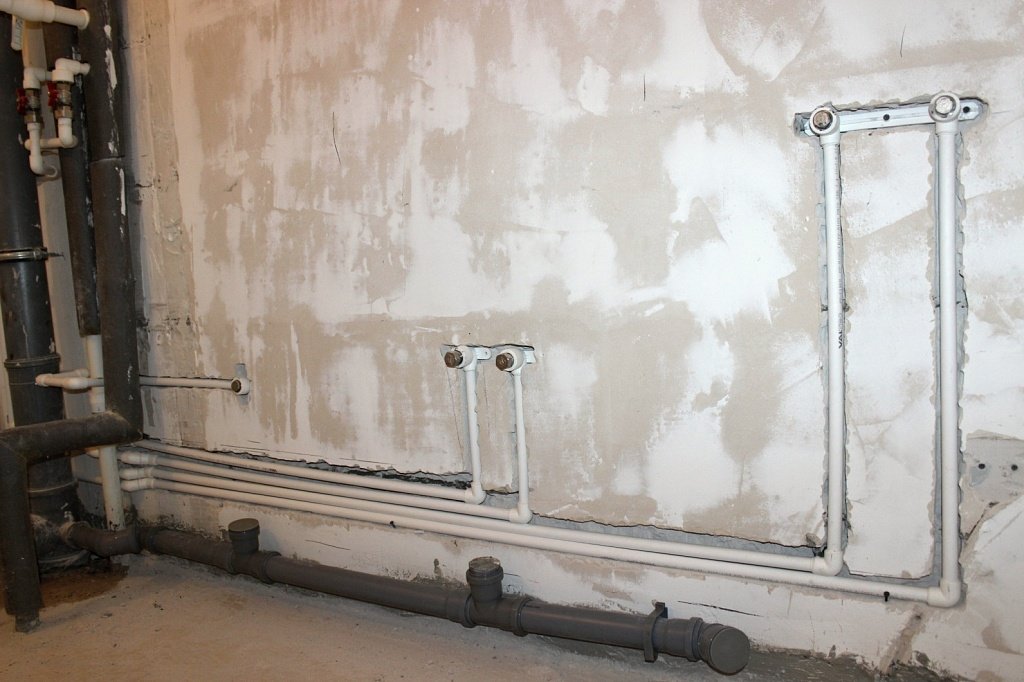
- Low maintainability. The first commandment of the plumber says: communication should be laid as openly as possible. This will make it possible to clean the pipe if it is clogged by a piece of scale that has flown from the main line, or to eliminate leakage at the fitting;
In general, from the slag and sand in the pipes are excellent help for the coarse filters installed at the entrance to the house or apartment.
- What is not less important, an open gasket will give you the opportunity, if necessary, to easily connect a new plumbing tool at any point of the water supply: it will be enough just to cut a tee into the straight section of the pipeline.
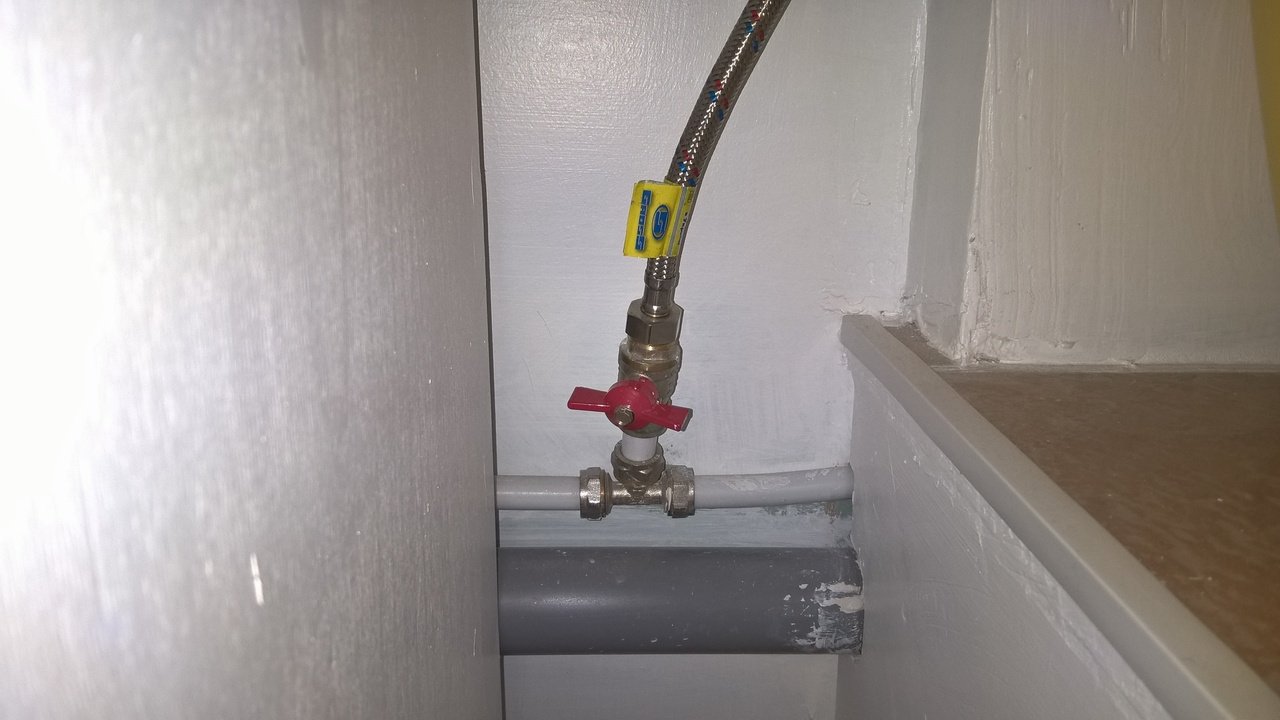
Independent disconnection
It can also be organized without a collector. For this purpose, before each mixer, cut off ball valves are placed. Their installation was impossible unless in the kitchens of the houses of the 70's and the earlier years of construction, with the piping mounted under wall-mounted mixers. Now, when the kitchens are mass-fed with faucets with a bottom line, put between the pipe and a flexible hose additional valve poses no problem.
The costs will not increase at all. The same valves we would have to put after the collector, at the beginning of the beam distribution.
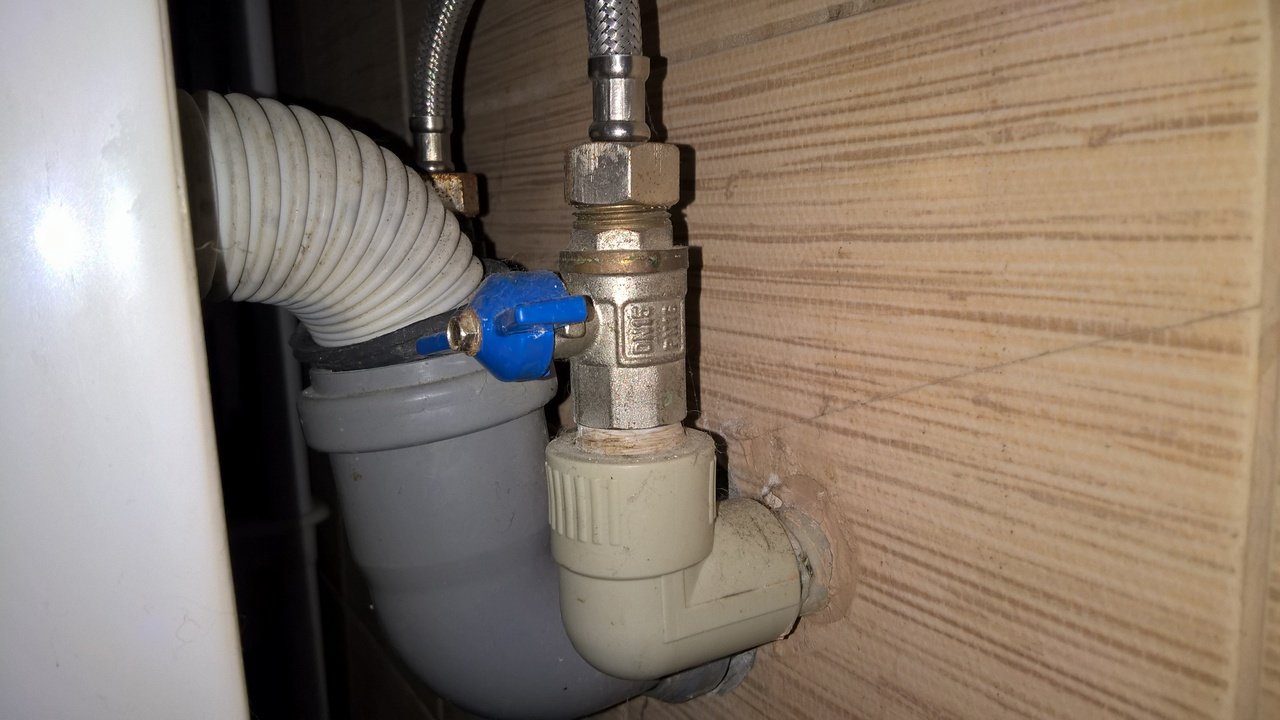
On the photo - the valve, which allows you to turn off the water on the washbasin faucet.
Head drop
I left this item for dessert.
The drop in the pressure of water at its flow through a serially connected sanitary device is the main scourge of the apartments of the old fund. Those who lived in them, willingly listens to tales about the need to install a collector to solve this problem.
Let us recall, however, one nuance. In old houses, steel pipes were used, which over time grow over rust and calcareous deposits.
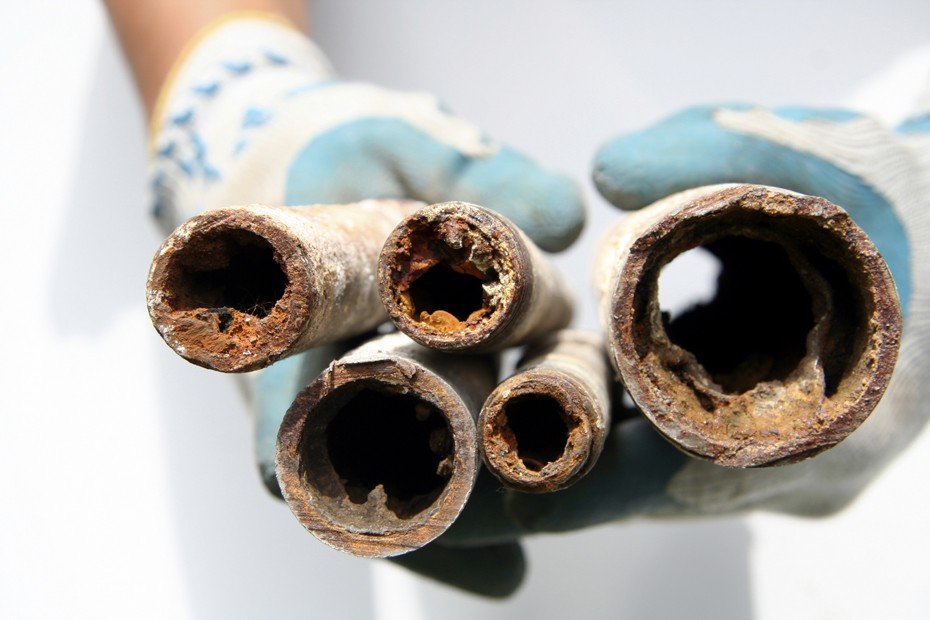
In new buildings, no drop in the pressure in the apartment is usually not observed: the pipes are still new.
Water distribution polypropylene pipes or metal plastic completely eliminates the owner of the housing from this problem: the internal section of the pipe does not change the entire period of its operation.
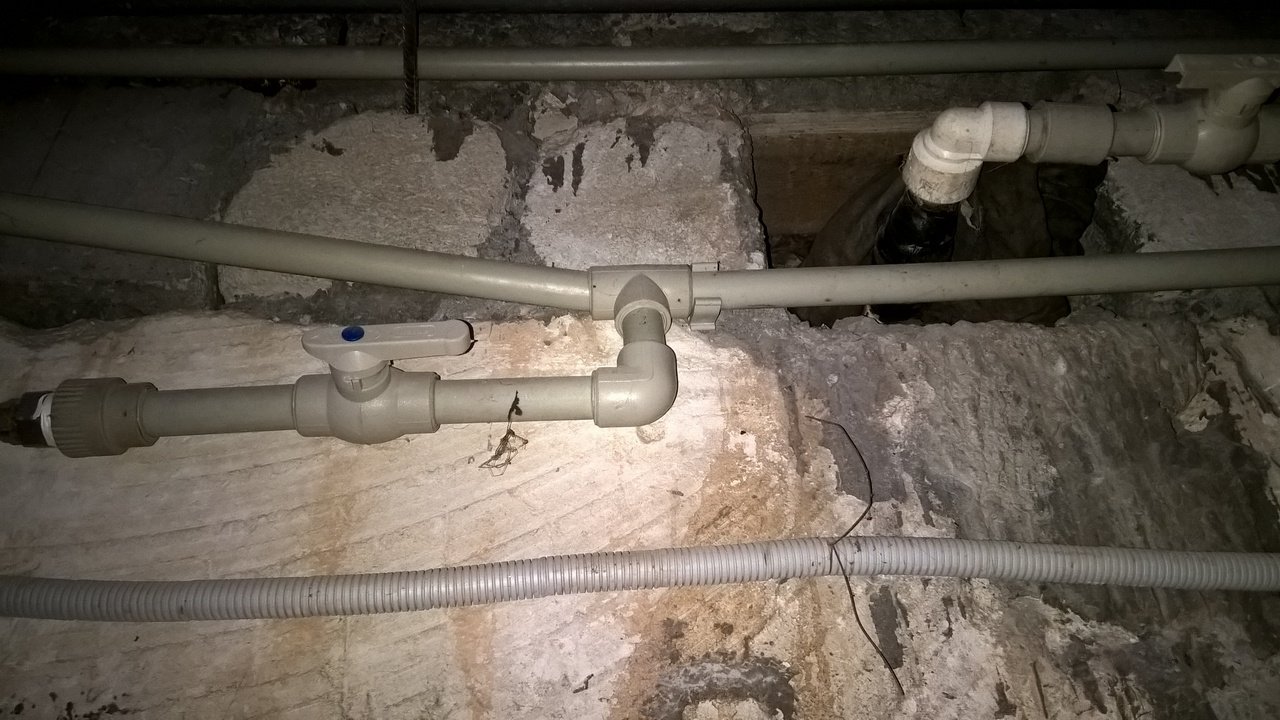
No, under certain conditions, a situation is possible when an open in the kitchen faucet will force someone in the shower to say a couple of unflattering words. This occurs when the inlet section is underestimated (in particular, when using a metal-plastic pipe with an external diameter of 16 mm). The fact is that the internal diameter of this tube is only 11 - 12 mm against 15 in a half-inch steel pipe; Moreover, at the fittings the cross section decreases even more.
Meanwhile, the cross-sectional area (and, hence, the capacity) of a pipe is proportional to the square of its internal diameter. Its decrease from 15 to 11 mm will reduce the capacity of the pipeline to (11/15) ^ 2 = 0.537 initial.
Here is a simple instruction that completely eliminates the drop in pressure:
- When installing the water pipe with your own hands, pipes with an inner diameter of at least 15 mm are used for wiring (for metal plastic and polypropylene it corresponds to the outer diameter of 20 mm);
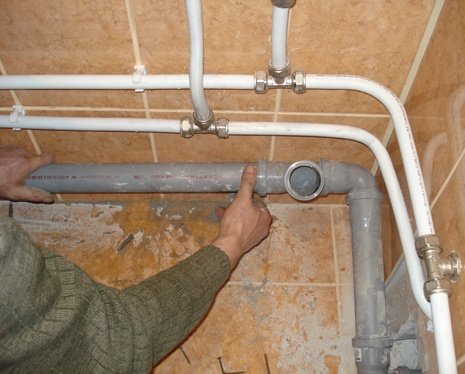
- Sites that feed three or more plumbing fixtures that can be used at the same time are bred by a pipe for a step of a larger diameter (26 mm). In flats, however, pipes of this diameter are not used: they can be claimed only in private houses with several.
Costs
Another aspect of the problem is costs. In which case will they be more? Of course, taking into account the increased cross-section of the water pipe with a tee wiring?
The answer is not as straightforward as it seems.
Let's perform an uncomplicated calculation for an apartment very typical for old houses with an adjacent layout of the combined bathroom and kitchen. The lengths of the leaks are equal:
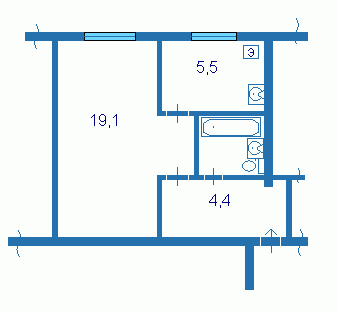
And here approximate prices for Valtek metal-polymer pipes:
With a collector wiring, you can safely use a diameter of 16 mm for all devices. The total length of the leads on the cold and hot water will be (1.5 + 2.2 + 3) * 2 + 0.5 = 13.9 meters. The cost of pipes of this length will be 13.9 * 63 = 875.7 rubles.
In the case of serial wiring, the total length of the wiring consists of:
- Pipe connecting the valve with a distant device;
- Vertical areas under each mixer (their height is on average 30 cm under the sinks and 50 cm under the bathroom).
In our case, the calculation will give us the total length (3 + 0.3 + 0.5) * 2 = 7.6 meters. With a cost per meter of 100 rubles. the cost of pipes will be 760 rubles. The need to purchase tees is offset by the expensive combs needed for manifold wiring.
![]()
The collector Valtek VTc.580.0503 (3/4, 3х1 / 2). The retail price is 924 rubles.
As it is easy to see, the cost of buying pipes in both cases differs by less than 20%.

